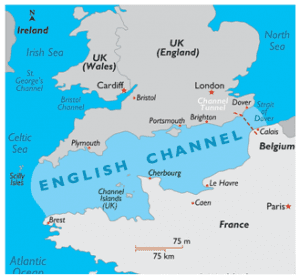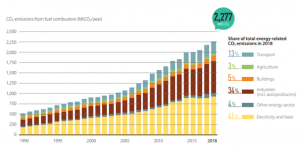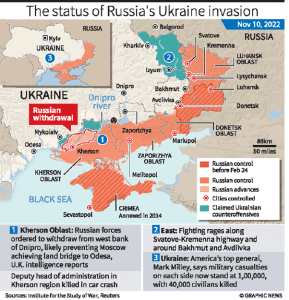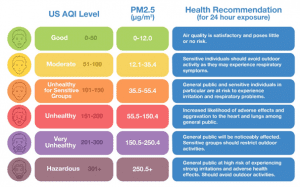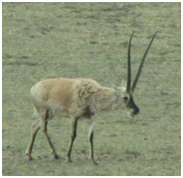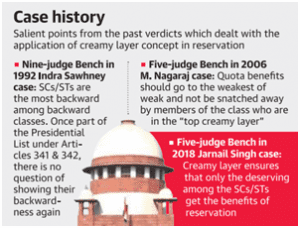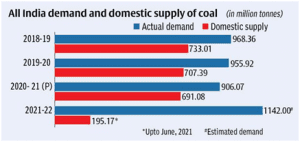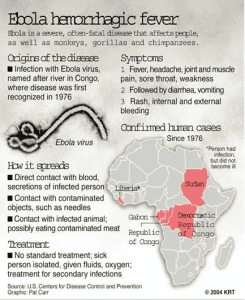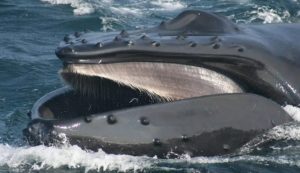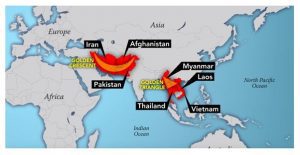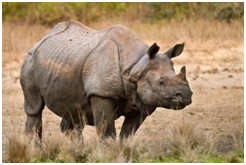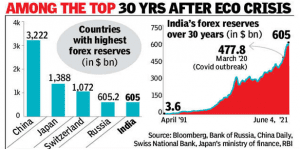DAILY CURRENT AFFAIRS (NOVEMBER 15, 2022)
INDIAN POLITY AND CONSTITUTION
1. FIRST AMENDMENT TO CONSTITUTION CHALLENGED
THE CONTEXT: Recently, the Supreme Court agreed to hear a petition challenging the 1st Constitutional amendment’s expansion of restrictions on the freedom of speech and expression (Article 19(1)(a)) on the grounds that the amendment violates the basic structure doctrine.
THE EXPLANATION:
Article 19 of the Indian Constitution: Protection of certain rights regarding freedom of speech, etc.
Rights enlisted under Article 19 (1): All citizens shall have the right –
(a) to freedom of speech and expression;
(b) to assemble peaceably and without arms;
(c) to form associations or unions;
(d) to move freely throughout the territory of India;
(e) to reside and settle in any part of the territory of India;
(g) to practise any profession, or to carry on any occupation, trade or business.
Reasonable restrictions are imposed on Article 19(1)(a) in 19(2): In the interests of
- The sovereignty and integrity of India,
- The security of the State,
- Friendly relations with foreign States,
- Public order, decency or morality,
- In relation to contempt of court,
- Defamation,
- Incitement to an offence.
The 1st amendment to the Indian Constitution:
Background:
- In State of Madras v. Champakam Dorairajan (1951), the SC held that the reservation in government jobs and colleges cannot be provided on the basis of caste, as it violates Article 29(2) of the Indian Constitution.
- Article 29(2): The State shall not deny admission to any individual to educational institutes maintained by or those receiving help from it solely on the basis of race, religion, caste, language, or any of them.
- The Constitution (First Amendment) Act, 1951 was enacted in response to this judgement.
About the Constitution (First Amendment), Act 1951:
- It made numerous significant changes in the Constitution, including exempting land reforms from scrutiny and providing protections for backward classes.
- Notably, it broadened the extent of the restrictions on the right to free expression.
- This amendment established the precedent of modifying the Constitution to overcome judicial decisions restricting the government’s perceived responsibilities to specific policies and programs.
- The first amendment made two key changes in Article 19(2):
- First, it introduced the qualification “reasonable” to the restrictions that Article 19(2) imposed, which leaves the door open for the courts to intervene and review the validity of restrictions imposed by Parliament.
- Second, the amendment introduced into the Constitution the specific terms “public order” and “incitement to an offence”.
- This new set of narrower terms in the provision was necessitated by two SC rulings in 1950 that went against the state’s power to curb free speech.
- Both these verdicts (Brij Bhushan v State of Delhi (March 1950), and Romesh Thappar v State of Madras (May 1950)) involved the press.
- In both the cases, the court had to define the terms “public safety” and “public order” and examine if they fell within the scope of the restrictions allowed in Article 19(2).
- The court struck down the laws imposing restriction on free speech on the grounds of “public safety” and “public order” as unconstitutional.
The basic structure doctrine:
Background:
- The idea of basic structure has been borrowed from Germany.
- It was originally suggested in the Sajjan Singh case (1965) by the Supreme Court of India.
- In Kesavananda Bharati case (1973), the SC by a 7-6 majority held that Parliament can amend the Constitution but does not have power to destroy its “basic structure”.
INTERNATIONAL RELATIONS
2. G20 SUMMIT HIGHLIGHTS
THE CONTEXT: Heads of state and governments belonging to 20 of the world’s major advanced and emerging economies have gathered for a two-day summit meeting in Bali, Indonesia.
THE EXPLANATION:
- At the end of the meeting, India, represented by Indian Prime Minister, will assume charge of the G20 presidency.
- The 18th summit will be held in India next year.
The Bali summit will have three key priorities:
1. Global Health Architecture: This involves deliberations towards strengthening global health resilience and making the global health system more inclusive, equitable, and responsive to crises.
2. Digital Transformation: Deliberations here have centred on achieving the full potential of rapid digitalisation of the global economy by creating a new landscape of cooperation among nations.
3. Sustainable Energy Transition: The discussions have focussed on ways to accelerate the transition towards cleaner energy sources.
In particular, since any such transition requires substantial investments, the efforts have been focussed on finding a platform for such investments.
What else is at stake?
- The G20 countries are considered as the engines of global growth as they account for 60 per cent of the world’s population, 80 per cent of the world’s GDP and 75 per cent of the world’s exports.
- However, since the October 2021 summit in Rome, prospects of the global economy have worsened.
- A recent report of the International Monetary Fund on G20 countries shows, most of the G20 constituent countries have suffered significant output losses since the start of the Covid-19 pandemic.
- India, for instance, would have lost almost 14 per cent of its total output — the highest loss among all G20 countries.
ENVIRONMENT, ECOLOGY AND CLIMATE CHANGE
3. DECLINE IN MANGROVES
THE CONTEXT: According to a study published in the journal Ecological Informatics, certain mangrove species in Chilika and Sundarbans along the east coast and Dwarka and Porbandar along the west coast of India is likely to reduce and shift landward by 2070 due to decline in suitable habitats in response to precipitation and sea level changes.
THE EXPLANATION:
- Scientists at the BSIP, an autonomous institution of the Department of Science and Technology (DST), used Ensemble species distribution model to study the past and current state of two mangrove species and predict their future.
- They found significant reduction and landward shift of mangroves in the future (2070) due to decline in suitable habitats, specifically along the east and west coast of India in response to precipitation and sea level changes in the future.
- In contrast, the maximum range expansion of the mangroves was mapped in the past, which was validated by fossil pollen data.
- The findings would be useful in the implementation of mitigation and adaptation strategies in the identified hotspots for conserving the coastal wetlands and reducing the impact of climate change on the coastal vegetation along the Indian coastline.
- The Indian coastline is vulnerable to the impact of climate and sea level changes, and there is not much attempt for the coastal wetland species prediction and management, with limited research carried out for their future habitat mapping.
- To fill this gap, this study tried to project the potential impact of climate change on mangroves as coastal wetland species.
- The study suggests that establishing effective buffer zones in these conserved areas can narrow down the effect of non-conservative areas on the core conservative zone, and adopting preventive measures can turn some areas into highly suitable regions for facilitating the growth of these mangrove species.
Value Addition:
- Mangroves are woody plants, forming the only tall tree forests in the world, ably located between land and sea in tropical and warm temperate coasts. Mangroves are specially adapted to harsh environment, where no other plant species can survive.
- Mangroves represent a characteristic littoral (near the seashore) forest ecosystem.
- These are mostly evergreen forests that grow in sheltered low-lying coasts, estuaries, mudflats, tidal creeks backwaters (coastal waters held back on land), marshes, and lagoons of tropical and subtropical regions.
- Mangroves are the only ‘blue carbon’ forests of the ocean, and are also known as ‘Coastal woodland’, ‘Oceanic rainforest’ and ‘Tidal forest.
- Mangrove forests are ecologically significant and economically important. They provide ecosystem services worth at least US$ 1.6 billion each year and support coastal livelihoods worldwide . They serve as the nursery, feeding and breeding grounds for crabs, prawns, mollusks, finfish, birds, reptiles and mammals. A large amount of global fish catches (up to 80%) is dependent on mangroves, thereby ensuring the food security of coastal people.
Mangroves in India
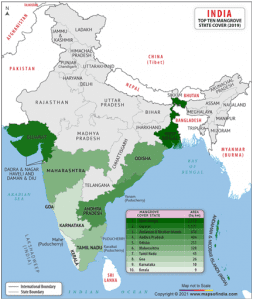
4. LONG-TERM LOW EMISSION DEVELOPMENT STRATEGY
THE CONTEXT: India recently submitted its Long-Term Low Emission Development Strategy to the United Nations Framework Convention on Climate Change (UNFCCC), during the 27th Conference of Parties (COP27).
THE EXPLANATION:
The salient features of the strategy are:
- The focus will be on the rational utilization of national resources with due regard to energy security. The transitions from fossil fuels will be undertaken in a just, smooth, sustainable and all-inclusive manner.
- The National Hydrogen Mission launched in 2021 aims to make India a green hydrogen hub.
- Increased use of biofuels, especially ethanol blending in petrol, the drive to increase electric vehicle penetration, and the increased use of green hydrogen fuel are expected to drive the low carbon development of the transport sector.
- Smart city initiatives, integrated planning of cities for mainstreaming adaptation and enhancing energy and resource efficiency, effective green building codes and rapid developments in innovative solid and liquid waste management.
- Improving energy efficiency by the Perform, Achieve and Trade (PAT) scheme, National Hydrogen Mission, high level of electrification in all relevant processes and activities, enhancing material efficiency and recycling leading to expansion of circular economy, and exploring options for hard-to-abate sectors, such as steel, cement, aluminium and others.
- India is on track to fulfilling its NDC commitment of 5 to 3 billion tonnes of additional carbon sequestration in forest and tree cover by 2030.
- Provision of climate finance by developed countries will play a very significant role and needs to be considerably enhanced.
India’s approach is based on the following four key considerations that underpin its long-term low-carbon development strategy:
- India has contributed little to global warming, its historical contribution to cumulative global GHG emissions being minuscule despite having a share of ~17% of the world’s population.
- India has significant energy needs for development.
- India is committed to pursuing low-carbon strategies for development and is actively pursuing them, as per national circumstances
- India needs to build climate resilience.
The two themes of “climate justice” and “sustainable lifestyles”, alongside the principles of Equity and Common But Differentiated Responsibilities and Respective Capabilities (CBDR-RC), in the light of national circumstances, that India had emphasized at Paris, are at the heart of a low-carbon, low-emissions future.
5. ATOMIC ENERGY, HYDROGEN POWER INDIA’S NET ZERO PLAN
THE CONTEXT: Recently, India announced its long-term strategy to transition to a “low emissions” pathway at the United Nations Conference of Parties (COP) ongoing in Sharm el-Sheikh, Egypt.
THE EXPLANATION:
LT-LEDS (Long Term-Low Emission Development Strategy):
- At the ongoing COP27, India announced its long-term strategy to transition to a “low emissions” pathway i.e. LT-LEDS.
- The LT-LEDS is a commitment document which every signatory to the Paris Agreement (2015) is obliged to make by 2022.
- So far, only 57 countries (including India) have submitted their document.
- India’s strategy is mainly based on expanding India’s nuclear power capacity by at least three-fold in the next decade, apart from becoming an international hub for producing green hydrogen and increasing the proportion of ethanol in petrol.
- This strategy is in line with India’s goal of being carbon neutral by 2070 — a commitment made by Prime Minister Narendra Modi at Glasgow, UK where the 26th COP was held last year.
India’s LT-LEDS includes
Mode of Transportation –
- India “aspires” to maximise the use of electric vehicles, with ethanol blending to reach 20% by 2025 (it is currently 10%).
India also aims for a “strong shift” to public transport for passenger and freight traffic.
Carbon Sequestration –
- India will also focus on improving energy efficiency by the Perform, Achieve and Trade (PAT) scheme, the National Hydrogen Mission, increasing electrification, enhancing material efficiency, and recycling and ways to reduce emissions.
- India’s forest and tree cover are a net carbon sink absorbing 15% of CO2 emissions in 2016.
- The country is on track to fulfilling its Nationally Determined Contributions (NDC) commitment of 2.5 to 3 billion tonnes of additional carbon sequestration in forest and tree cover by 2030.
On Climate Finance –
- The document underlined that this transition entailed costs ranging in “trillion dollars” that the developed countries, responsible for the existing carbon accumulation, ought to be making good.
- The document says that provision of climate finance by developed countries will play a very significant role and needs to be considerably enhanced, in the form of grants and concessional loans.
VALUE ADDITION:
About COP27:
- The 27th session of the Conference of the Parties (COP27) to the United Nations Framework Convention on Climate Change (UNFCCC) is currently being held in Sharm El Sheikh, Egypt.
- The COP is the supreme decision-making body of the Convention.
- The climate change process revolves around the annual sessions of the COP.
- It meets every year, unless the parties decide otherwise.
- The next conference of parties i.e. COP28 will be held in Dubai, UAE in November, 2023.
PRELIMS PERSPECTIVE
6. ILLEGAL, UNREPORTED AND UNREGULATED (IUU) FISHING
THE CONTEXT: According to Indian Navy, as many as 392 reported incidents of illegal, unreported and unregulated fishing were monitored in 2021 compared to 379 in 2020 in the Indian Ocean.
THE EXPLANATION:
- Illegal, unreported and unregulated (IUU) fishing continues to rise beyond India’s Exclusive Economic Zone (EEZ).
- Chinese fishing vessels, fishing vessels from European Union countries and other countries from outside the region were observed to be fishing in the Indian Ocean.
- Chinese deep sea trawlers have been a matter of concern for countries in the region, including India, as they are operating far from the Chinese coast and impacting local marine ecology.
- Most of the illegal activity is found in the Northern Indian Ocean Region (IOR).
IUU fishing:
IUU fishing depletes fish stocks, destroys marine habitats, puts fishermen at disadvantage and impacts coastal communities, especially in developing countries.
Information Management and Analysis Centre (IMAC):
- The presence of extra-regional distant water fishing fleets has been monitored by Information Management and Analysis Centre (IMAC).
- The Quad, comprising India, Australia, Japan and U.S., in May 2022 announced a major regional regional effort under the ambit of Indo-Pacific Maritime Domain Awareness (IPMDA).
- It aims to provide a more accurate maritime picture of “near-real-time” activities in the region.
- It is expected to catalyse joint efforts of India and other Quad partners towards addressing IUU in Indo-Pacific region.
- All vessel movements on the high seas are monitored by the Indian Navy’s IMAC in Gurugram and the Information Fusion Centre-Indian Ocean Region (IFC-IOR) which is co-located with it.
- IFC-IOR has been collaborating with other regional monitoring centres across the globe to enhance maritime safety and security, including efforts to monitor IUU.
Regional fisheries management organisations:
- As per United Nations Convention on the Law of the Sea (UNCLOS), coastal nations are responsible for addressing IUU fishing issues within their respective EEZ.
- There are regional fisheries management organisations such as the Indian Ocean Tuna Commission, Southern Indian Ocean Fisheries Agreement operating under the mandate of UNCLOS as regulatory bodies to monitor IUU fishing on the high seas.
Global Regulations:
There are two main regulations globally on IUU fishing:
1. the Cape Town Agreement and
2. the Agreement on Ports State Measures.
THE PRELIMS PRACTICE QUESTION
QUESTION OF THE DAY
Q1. Dover strait connects which of the following water bodies?
a) North Sea and Baltic Sea
b) English channel and North Sea
c) Atlantic Ocean and Mediterranean Sea
d) Mediterranean Sea and Black Sea
Answer: B
Explanation:
Please refer to the map-
